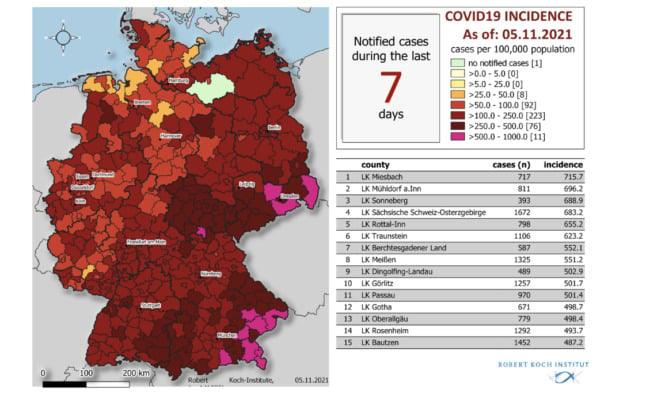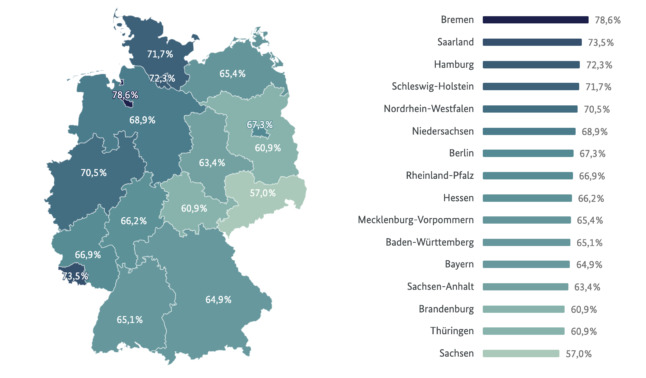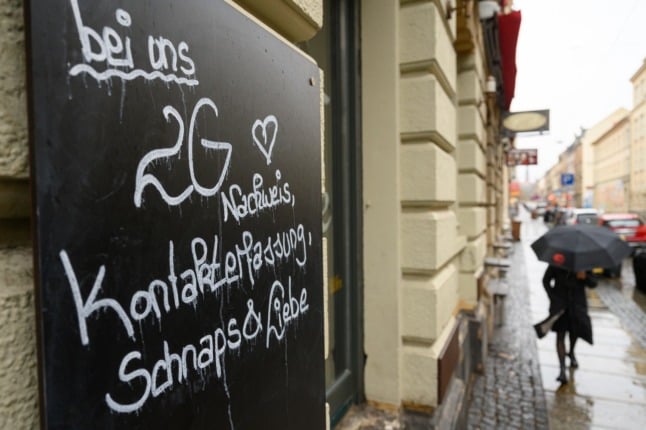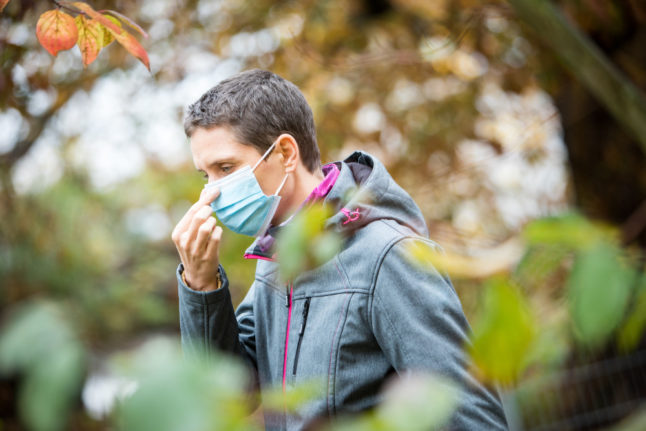Germany is seeing a record number of daily Covid cases, increasing hospitalisations and deaths as it battles the fourth wave.
But nowhere are the numbers as bad as in the south-east of the country – particularly the states of Saxony, Thuringia and Bavaria.
“Those are the three hotspots we have in Germany,” Saxony’s health minister Petra Köpping said.
Nationwide there were were 37,120 daily infections reported on Friday. The 7-day incidence reached 169.9 infections per 100,000 people.
In Thuringia, however, it was more than twice as high at 386.9. Saxony was almost on the same level with 385.7, followed by Bavaria with 256.8. In several districts of the three states, the incidence has spiralled over 500. In the Upper Bavarian district of Miesbach the 7-day incidence has risen above 700 Covid infections per 100,000 people.
The map below by the RKI shows the Covid incidences in Germany. The pink areas show districts with incidences over 500 cases per 100,000 people.

The three states – desperate to bring down the numbers – are already looking at introducing tougher rules.
An urgent appeal came from Saxony’s state premier Michael Kretschmer on Friday. “If we take too much time now, it will end in a lockdown like last year,” the CDU politician told Deutschlandfunk.
Measures must be taken now and not in two or three weeks, he added.
Kretschmer has called for a crisis meeting between state premiers and the government to thrash out a new strategy on controlling the Covid spread.
Lower vaccination rates
Experts say there are several reasons why Germany is seeing a spike in cases. We’re dealing with the more transmissible Delta wave, people are socialising again, plus it’s colder now and the virus spreads better indoors. But there’s another factor: experts say not enough people in Germany are fully vaccinated.
READ ALSO: Why are Covid infections in Germany rising?
According to the latest government figures, 67 percent of the population is now fully vaccinated, while around 70 percent have been given at least one dose.
Breaking it down into age groups, 73.4 percent of the 18-59-year-olds have been fully jabbed, and 85.4 percent of the over 60s.
Authorities ideally want to see at least 85 percent of people aged 18 to 59, and 90 percent of those 60 and over vaccinated against Covid-19.
For all everyone has pointed at the UK as a terrible warning and Germany as some sort of example, the case rates are now similar. German vaccine coverage is frustratingly lower and how this is all going to play out with hospitalisations and deaths has people worried. https://t.co/J0H1cPKned
— Laura Howes (@L_Howes) November 5, 2021
In the states where Covid cases are spiking, vaccination rates do tend to be lower than the average.
“There is a very clear correlation (of rising Covid cases) with the level of vaccination,” Leipzig epidemiologist Markus Scholz, who is mainly analysing the situation in Saxony, told Welt.
READ ALSO: How to explain vaccine hesitancy in Germany?
The eastern state brings up the rear in terms of Covid vaccinations in Germany: 57 percent of the population was fully vaccinated as of Friday, compared to 67 percent nationwide. Thuringia was also below average with 60.9 percent, as was Bavaria where 64.9 of the population is fully jabbed.

In Saxony, there are neighbouring districts which are structurally similar and only differ when it comes to the vaccination rate. Scholz said a low vaccination rate corresponds to a higher number of infections.
READ ALSO: Why are fewer people getting vaccinated in the east of Germany?
Not only about vaccinations
But lower vaccine uptake cannot be the only explanation, because the state of Brandenburg, which surrounds Berlin, also has a weak vaccination rate of 60.9 percent, but nowhere near as high an incidence (the 7-day incidence was 179.6 Covid cases per 100,000 people on Friday).
In previous Covid waves, it was suspected that the higher-than-average age of residents in Saxony and Thuringia might play a role. The rural structures, the closer family ties and the sociable club culture were also cited as potential factors.
Border traffic with the Czech Republic and Austria is also thought to play a role. Thuringia, however, is not on the border.
READ ALSO: Why Covid cases remain high on the German border with Austria
The health ministry in Thuringia’s Erfurt sees two main reasons for the high numbers besides the low vaccination rate: the accumulation of Covid-19 outbreaks in Kindergartens and schools, and the late end of the summer holidays.
Along with Saxony, Bavaria and Baden-Württemberg, Thuringia was one of the federal states with a later end to school holidays. The incidences among 6 to 17-year-olds there have spiked above 600 in recent weeks, according to the ministry.

So these factors – the late return of travellers, the start of the cold season and closer indoor contact – could all be contributing.
In Bavaria, the border region with Austria has been hit particularly hard. State premier Markus Söder (CSU) said this week that there is not only a nationwide difference, but also a Bavarian north-south divide in vaccination rates.
However, in districts with particularly high incidences, the vaccination rate is sometimes higher than the Bavarian average.
So it’s not a clear picture on why so many people are picking up Covid.
Authorities in the hotspot of Miesbach, for instance, are no longer able to keep up with the exponentially rising cases and contact tracing so they don’t know exactly what’s happening in communities.
Will tougher restrictions turn it around?
Federal Health Minister Jens Spahn said earlier this week that Germany was seeing a ‘massive pandemic of the unvaccinated’. German states are trying to tackle the fourth wave by piling pressure on vaccine-hesitant people and vaccine refusers.
Bavaria has a ‘warning light’ system in place depending on the intensive care situation.
READ ALSO: How German states are tightening Covid rules for winter
In areas with a ‘red warning’ – an incidence of over 300 and with at least 80 percent of intensive care beds occupied – only vaccinated and recovered people (2G) can enter many public places.
However, gastronomy and service providers such as hairdressers, where a negative PCR test is enough, as well as public transport and retail will be exempt. Throughout Bavaria, schoolchildren will have to wear masks again after the autumn holidays.
Saxony and Thuringia are also trying to tighten the reins. Thuringia’s health minister Heike Werner (the Left party) is looking at tougher restrictions on the unvaccinated, especially as the situation in hospitals is getting worse.
Saxony plans to introduce 2G rules which would see unvaccinated people excluded from many public places.
But will 2G bring about a turnaround? Epidemiologist Scholz warns that even vaccinated people should be careful with lots of Covid cases circulating.
Experts say vaccination protection decreases after six months, most rapidly among older people. “The vaccinated risk groups are now at risk again, so you have to be careful,” said the Leipzig scientist.
That’s why people over 70 urgently need a booster shot now, said Scholz.
German health ministers recommend that vaccinated people – especially risk groups or those who’ve had vector vaccines – get a booster Covid jab six months after their last dose to combat waning immunity.



 Please whitelist us to continue reading.
Please whitelist us to continue reading.
Still always better to mention different mortality and severity of symptoms between unvaccinated and vaccinated